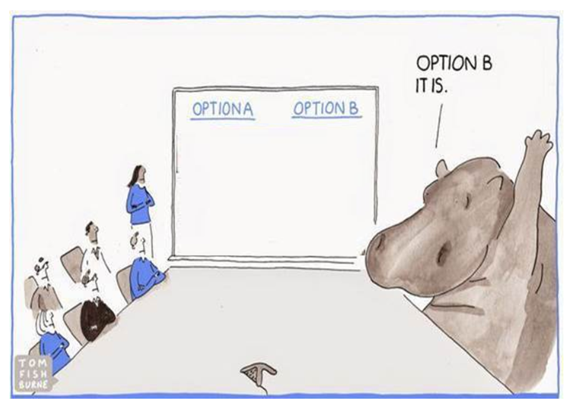Have you ever started a project sure that it would never work out, but the boss gave the order, and “The boss is always right.”, correct? Have you ever developed a product/service during which everyone had this unfounded optimism, and then at delivery, the results never materialized?

Here are five situations you can end up in if you don’t use metrics for decision-making.
HIPPO – The weight of the name tag
Here’s the situation: it’s time to prioritize projects, and you and your whole team are sure that option “A” is the best choice, but since there’s a director (or someone higher in the hierarchy), we end up going with his choice of option B. This situation is the notorious HIPPO: Highest Paid Person Opinion. In other words, without data and facts, the call goes to the person highest up in the company’s hierarchy.

HIPPO War – Whoever shouts the loudest
If we’ve no numbers, then the HIPPO’s opinion wins, but what about when we’ve several HIPPOs shouting their priorities at the team? Example: the Director of Marketing says we must do project A, the Director of Operations wants project B, the IT Director goes straight to the team saying option C is essential for the company, and so on.

The team dances according to whoever shouts the loudest. Like in a big rock concert, you go back and forth, not knowing what strategy is to be followed. Plenty of things are begun, very little is finished, and everyone starts thinking, “What am I doing here?”

I’ll break the internet!
Moving away from the context of a company and projects for a moment, let’s talk about social media. How often have you written a post for Facebook or Linkedin, and thought: “Dude, this post is going to break the internet! It’s going viral. I can already see the newspapers commenting my post. It’ll be the Ultimate Great Huge Post of The Century”. Then you publish it and…nothing happens. Not even one lousy Like.
Your phone vibrates, a notification! Someone’s commented. You’re euphoric. It’s your best friend. You think: “I knew my bro would get it.” You eagerly click on the notification, only to see it’s just a thumbs-up emoticon.
Damn it, you were sure that the post was going viral, but no one paid any attention. Well, many projects are chosen merely based on the feeling they’d turn outright. They take months or years to be produced, and when delivered, generate a meager return and probably thumbs-down emoticons from directors, presidents, and investors.

Intuition
Donald Reinertsen, in his book The Principles of Product Development Flow, suggests we ask the following question in meetings for prioritizing projects: What would be the pre-tax cost be to the company if there were a 60-day delay in the delivery of a project to the market? He discovered that using only intuition, people’s estimates of this figure varied up to 50 times. That means that in one same group, for one single project, some people would say the impact would be $10,000 and others $500,000.
In a recent video, he says that in the best case, the variation was ten times, and in the worst, 200.
Using intuition to choose products isn’t a good idea, because different perspectives will suggest other consequences if there is nothing to base anything on.
Bear the consequences
The project was prioritized based on intuition and feelings, built, delivered, and had a meager return. If we use short experimentation and validation cycles and discover this situation in weeks, it’ll serve as a lesson. We’ll avoid this type of decision and can move on.
But if it takes years or months to discover the product or service isn’t suitable for the market, we’ll have to bear the consequences:
- How to pay for the losses?
- Reduce the team/company (firings).
- Who’s to blame for the failure (Witch hunt)?
We can disregard metrics on prioritization, development, and even delivery, but a time will come when they can no longer be ignored. Either the clients buy our product/service, or we won’t be able to pay the bills. Looking at the numbers afterward is disastrous.
Getting out of this mess with metrics
“The team’s true empowerment lies in the metrics.”
(Rodrigo de Toledo)
Instead of going into a meeting armed with nothing but “I guess…”, have metrics which prove that there is a real business problem that needs to be solved by your company, and the solution you’re opting for is the best way of treating it.
Also, metrics don’t only serve to take prioritization decisions. We should follow them the whole time, so we know how much of the problem we’ve solved. Like a runner whose objective is to complete a 42km marathon, our team should be clear about how far to go before the goal is reached and the run finished.
We commented on various agile metrics in this post and how they can help you make better decisions. We also mentioned a few metrics that should be avoided to not intoxicate your company’s environment.
Want to know more about metrics, which ones there are, how they work, and how to balance them? Take part in our Agile Metrics training and follow this blog for more updates.
